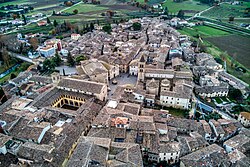Bevagna
Comune in Umbria, Italy From Wikipedia, the free encyclopedia
Comune in Umbria, Italy From Wikipedia, the free encyclopedia
Bevagna is a town and comune in the central part of the Italian province of Perugia (Umbria), in the flood plain of the Topino river.
Bevagna | |
|---|---|
| Comune di Bevagna | |
 | |
| Coordinates: 42°56′25″N 12°36′34″E | |
| Country | Italy |
| Region | Umbria |
| Province | Perugia |
| Frazioni | Cantalupo, Gaglioli, Limigiano, Torre del Colle, Campofondo, Castelbuono, Madonna della Pia |
| Government | |
| • Mayor | Annarita Falsacappa |
| Area | |
| • Total | 56.22 km2 (21.71 sq mi) |
| Elevation | 210 m (690 ft) |
| Population (31 December 2017)[2] | |
| • Total | 5,013 |
| • Density | 89/km2 (230/sq mi) |
| Demonym | Bevanati |
| Time zone | UTC+1 (CET) |
| • Summer (DST) | UTC+2 (CEST) |
| Postal code | 06031 |
| Dialing code | 0742 |
| Patron saint | Saint Vincent |
| Saint day | June 6 |
| Website | Official website |

Bevagna is 25 km (16 mi) south-east of Perugia, 8 km (5.0 mi) west of Foligno, 7 km (4.3 mi) north-north-west of Montefalco, 16 km (9.9 mi) south of Assisi and 15 km (9.3 mi) north-west of Trevi.
It has a population of c. 5,000, with the town of Bevagna proper accounting for about half of that. It is one of I Borghi più belli d'Italia ("The most beautiful villages of Italy").[3]
The city was originally an Etrusco-Oscan settlement. Around 80-90 BC it became a Roman municipium, called Mevania, in the Augustan Regio VI. It lay on the western branch of the Via Flaminia, 13 km (8.1 mi) west-north-west of Forum Flaminii, where the branches rejoin. It is mentioned on several ancient itineraries, following the Vicus Martis Tudertium on the way out of Rome.
In 310 BC the consul Fabius broke the Umbrian forces here; but otherwise it is not mentioned until the 1st century AD. In 69 the army of Vitellius awaited here the advance of Vespasian.
Pastures near the Tinia river and the white oxen of the Clitumnus River (the modern Clitunno) are mentioned by Propertius, whose family was from the area (from Assisium, Hispellum, or Mevania itself): they may refer to Mevania. Mevania is specifically mentioned by the later writers Silius Italicus, Lucan and Statius.
There are important remains of a temple near the north gate, of a theatre built into modern houses in the (misnamed) via dell'Anfiteatro, lesser remains of a second temple in the church of San Vincenzo near the east gate, mosaics belonging to midsized baths in the via Porta Guelfa, and very scanty remains of an amphitheatre at some distance from the modern town. The original walls, which have disappeared, were, according to Pliny (Hist. Nat. xxxv.173), built of unbaked bricks. The town now has a complete circuit of medieval stone walls that are said to be very near, if not identical with, the Roman walls.
After the Lombard conquest, it became the seat of a gastald in the Duchy of Spoleto, and after the year 1000 it was a free comune. In 1152 Frederick Barbarossa set it on fire. In 1249 it was again destroyed by the Count of Aquino. The Trinci family ruled it from 1371 to 1439. Later it was part of the Papal States until the unification of Italy.
The legendary account of Francis of Assisi preaching to the birds took place in a field outside Bevagna. The stone on which he allegedly stood when preaching to the birds is now in the Ciccoli Chapel of the Church of San Francesco.[4]
The main events held in Bevagna include:
Seamless Wikipedia browsing. On steroids.
Every time you click a link to Wikipedia, Wiktionary or Wikiquote in your browser's search results, it will show the modern Wikiwand interface.
Wikiwand extension is a five stars, simple, with minimum permission required to keep your browsing private, safe and transparent.